Welcome to the gateway of guitar mastery, starting with: The major guitar chords. These seven essential chords – C, D, E, F, G, A, and B – hold the key to unlocking a world of musical possibilities.
Understanding and mastering these first chords is crucial for any aspiring guitarist, as they provide the foundation for countless songs across various genres.
By immersing yourself in the world of guitar chords, you’ll experience a profound transformation in your playing, gaining the ability to strum along to your favorite tunes, compose your own music, and effortlessly communicate emotions through the power of sound.
Embrace the significance of these chords, and discover the incredible benefits they offer: increased dexterity, expanded musical vocabulary, enhanced improvisation skills, and the sheer joy of creating beautiful music that resonates with both your soul and others.
Get ready to unlock your full musical potential as we deep dive into basics of the 7 Major chords & answer some of your most frequently asked questions!

Basic Music Theory
The Musical Alphabet
The musical alphabet is a representation of the basic notes used in music, consisting of the letters A, B, C, D, E, F, and G.
These letters are assigned to specific pitches in a recurring pattern.
The musical alphabet is cyclical, meaning it repeats after reaching G, starting again with A.
The musical alphabet provides a consistent and organized system for identifying and communicating musical notes across different instruments and musical contexts.
It serves as a foundation for understanding scales, chords, and musical notation.
The Root Note
Root notes are like the “home” or starting point of a musical chord.
They are the main note that defines the name and character of the chord.
When playing a chord, the root note is the foundation upon which the rest of the chord is built.
It is the note from which the other notes in the chord are determined, and it provides a sense of stability and resolution in a song.
Understanding root notes helps you find the correct chord positions on the fretboard and allows you to play chords in different keys by shifting the root to different positions.
The Triad
A musical triad is a chord comprising three distinct notes stacked in thirds.
It consists of a root note, a third interval (either major or minor), and a fifth interval (either perfect, augmented, or diminished).
Triads are the fundamental building blocks of harmony in Western music, forming the basis of chords and chord progressions.
They provide the foundation for creating rich and diverse harmonies, giving a song its depth, character, and emotional quality.
The Major Guitar Scale
The major scale is a sequence of seven notes that has a happy and uplifting sound.
It’s like a musical “recipe” that guitarists use to create melody and chords in major keys.
Major guitar chords are derived from the major scale by picking specific notes from the scale and playing them together.
By understanding the major scale, guitarists can find which notes make up major chords and use them to create harmonies and play songs in a joyful and pleasing way.
Intervals
Musical intervals are the distances between two notes in music.
They determine the relationship and sound between the notes. In the context of major guitar chords, intervals play a crucial role.
Major chords consist of three notes: the root note, the major third interval (four steps above the root), and the perfect fifth interval (seven steps above the root).
These intervals create the distinctive sound of a major chord.
Major and Minor Chords
Major Chords
Major guitar chords are a set of chords that sound bright and happy.
They’re built using a specific pattern of notes called a major triad.
To identify a major chord, you need to find its root, which is the main note that gives the chord its name (For example, the root note of a C major chord is the note C).
Major chords also include a major third interval, which is 4 semitones above the root, and a perfect fifth interval, which is 7 semitones above the root.
By combining these three notes, you can form major chords in different positions and on different frets of the guitar.
Minor Chords
Minor guitar chords have a somewhat sad or melancholic sound.
They are formed by combining a root note, a minor third interval (3 semitones above the root), and a perfect fifth interval (7 semitones above the root).
Minor chords can be played in different positions & on different frets of the guitar, allowing you to create a variety of emotional & expressive sounds.
The 7 Basic Guitar Chords (Major Chords)
Finally, here’s the meat & potatoes of how to play the 7 basic chords. For all you beginner guitarists, if you didn’t already know how to read a guitar chord chart, here’s a quick primer of the symbols:
Vertical Lines: The vertical lines represent the guitar strings. The thickest string (low E string) is typically at the left side, and the thinnest string (high E string) is on the right side.
Horizontal Lines: The horizontal lines represent the guitar frets. The top line represents the nut or the open strings, and the lines below indicate the frets as you move up the neck. Sometimes there’s a number off to the side which tells you specifically what the fret number is.
Finger Placement: The numbers or dots on the chord chart show where to place your fingers on the fretboard. The numbers correspond to your fingers, with 1 being the index finger, 2 being the middle finger, 3 being the ring finger, and 4 being the pinky finger.
O: An “O” symbol above a string indicates that the string should be played open (unfretted).
X: An “X” symbol above a string means that the string should be muted or not played.
Okay, lets begin!
A Major Chord
Place your first finger (index) on the second fret of the third string (D) from the bottom.
Next, take your second finger (middle) & place it on the second fret on the third string(G) from the top.
Now, Take your third finger & place it on the second fret of the second string (B) from the top.
Finally strum all of the strings except the low e string.
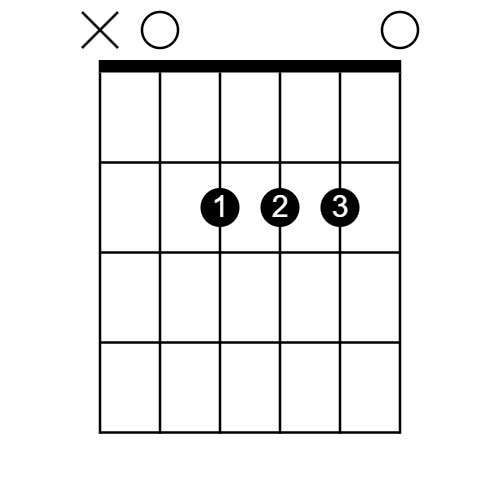
B Major Chord
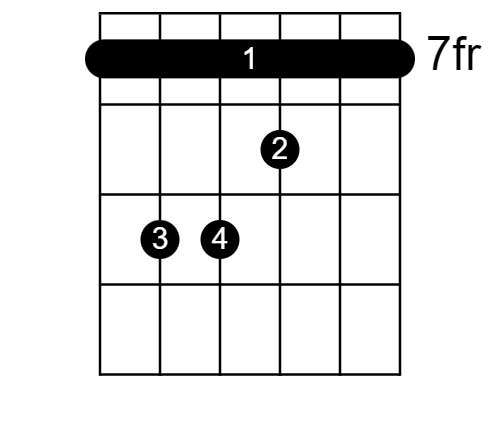
C Major Chord
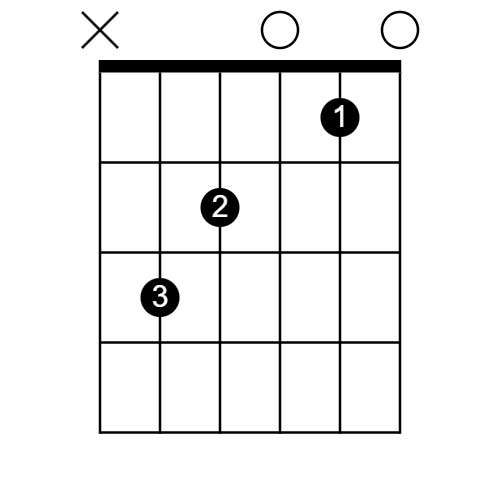
D Major Chord
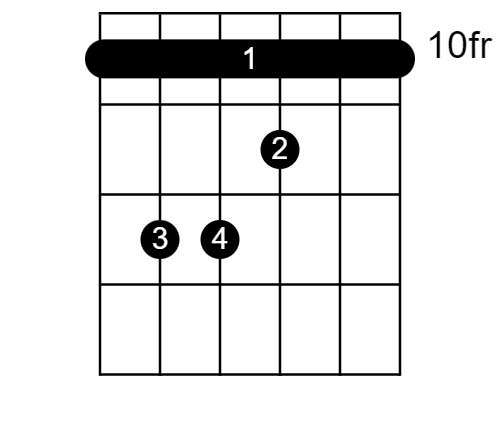
E Major Chord
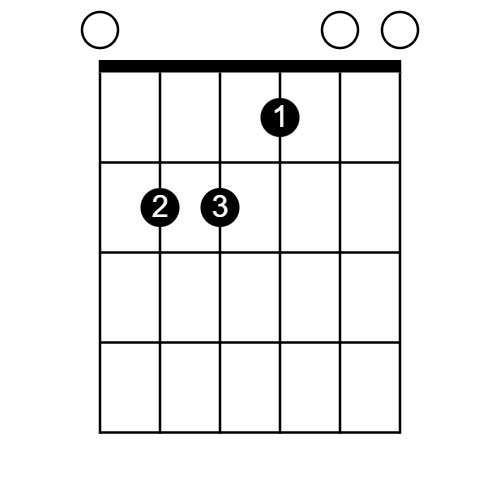
F Major Chord
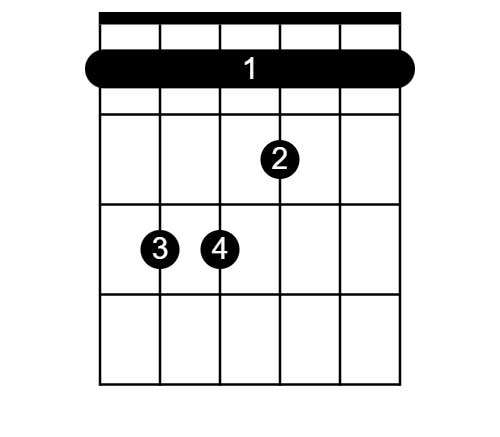
G Major Chord
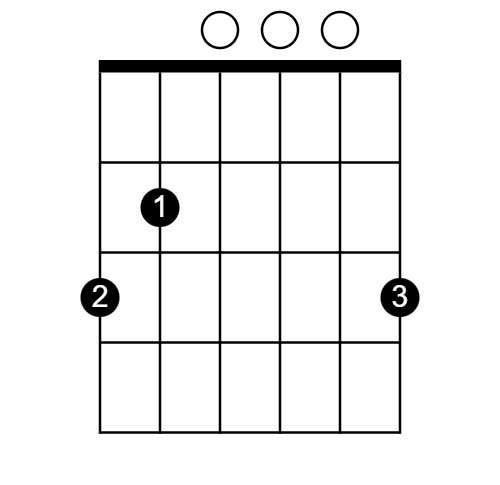
Explore More Guitar Chords
Easy Minor Chords On The Guitar

Frequently Asked Questions
What are the 12 major chords on a guitar?
The 12 major chords on a guitar are:
A, B, C, D, E, F, G, A#/B♭, C#/D♭, D#/E♭, F#/G♭, and G#/A♭.
Each basic major chord is named after a different note in the musical alphabet with the sharp or flat notes being placed in between the 7 natural notes.
How many chords exist in guitar?
The guitar is a versatile instrument that allows for numerous chord variations and combinations.
By using different chord shapes, inversions, and voicings, you can create countless unique chords.
Furthermore, chords can be modified by adding or omitting certain notes, resulting in even more variations.
In essence, the number of chords in guitar is practically infinite, providing a wide canvas for musical exploration and creativity.
But if you were to boil them all down into the most important guitar chords, there would be 12 basic chords total.
Related: How Many Guitar Chords Are There?
What are bar chords?(Barre Chords)
A barre chord is a type of chord where a single finger is used to press down multiple strings across the fretboard.
The index finger is typically used as a “bar” to hold down several strings at once.
By forming a “bar” with the index finger and using other fingers to create chord shapes behind the bar, guitarists can play a variety of chords that can be shifted up & down the fretboard.
Related: Learn To Play Barre Chords
What is the easiest chord on guitar?
The easiest chord for beginners on the guitar is often considered to be the E minor chord (Em).
It only requires pressing down two fingers on the fretboard.
To play an E min. chord, place your second finger on the second fret of the A string and your third finger on the second fret of the D string, while strumming all the strings from the A string downward.
The simplicity of the finger placement and the fact that it’s played with open strings make the Em chord a great starting point for beginners.
Which chords should I learn first on guitar?
The first chords we recommend starting by learning the 7 natural major chords as shown above in this article.
If you’re ready to explore more common chords yourself, we’ve also written this article which includes 5 easy chords for beginners.
